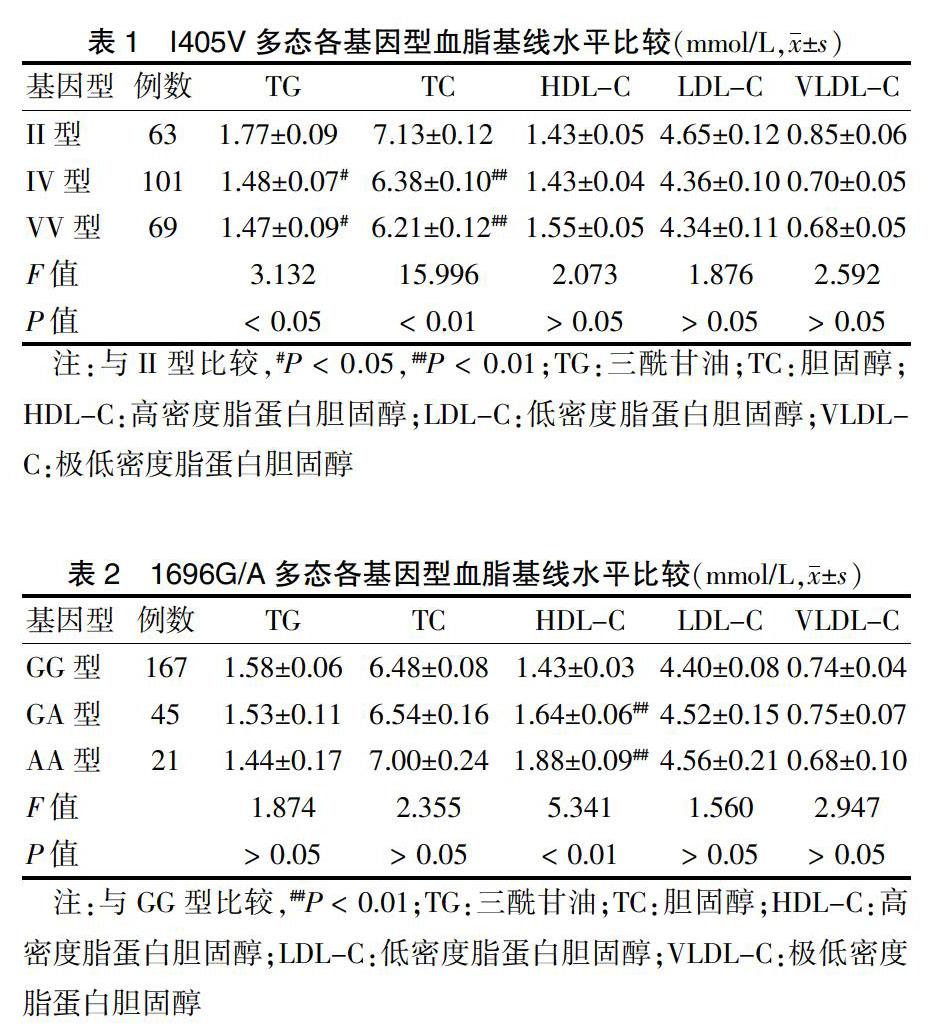CETP基因I405V、1696G/A多态与辛伐他汀疗效的相关性
李俊涛 郭志斌 陈志超 保泽庆 王敏 郑克勤


[摘要] 目的 探讨胆固醇酯转运蛋白(CETP)基因I405V多态、1696G/A多态与辛伐他汀调血脂效果的相关性。方法 选取2008年2月~2010年6月于广东医科大学附属医院治疗的血脂异常患者233例,采用聚合酶链反应-限制性片段长度多态(PCR-RFLP)方法检测I405V和1696G/A多态的基因型频率分布情况,并比较各基因型之间的各项血脂水平在辛伐他汀调脂治疗前后的变化。 结果 I405V多态II、IV及VV基因型分别为63例、101例和69例,1696G/A多态GG、GA及AA基因型分别为167例、45例和21例。辛伐他汀治疗后,II型患者三酰甘油(TG)、总胆固醇(TC)、低密度脂蛋白胆固醇(LDL-C)及极低密度脂蛋白胆固醇(VLDL-C)水平的下降幅度最为明显(P < 0.05或P < 0.01);1696G/A多态各基因型患者各项血脂水平变化量比较差异无统计学意义(P > 0.05)。 结论 辛伐他汀调血脂效果与CETP基因I405V多态相关。
[关键词] 胆固醇酯转运蛋白;血脂异常;辛伐他汀;三酰甘油;低密度脂蛋白
[中图分类号] R589.2 [文献标识码] A [文章编号] 1673-7210(2019)01(b)-0127-04
[Abstract] Objective To explore the association between the lipid-regulating effect of Simvastatin with I405V and 1696G/A polymorphisms in cholesteryl ester transfer protein (CETP) gene. Methods Two hundred and thirty-three cases of patients with dyslipidemia treated in Affiliated Hospital of Guangdong Medical University from February 2008 to June 2010 were selected. Polymerase chain reaction-restriction fragment length polymorphism (PCR-RFLP) technique was used to detect the genotype frequency distribution of I405V and 1696G/A polymorphisms, and the change of each blood-fat index among different genotypes was compared before and after Simvastatin treatment. Results The distribution of II, IV and VV genotype of I405V polymorphism were 63 cases, 101 cases and 69 cases respectively. The GG, GA and AA genotype distribution of 1696G/A polymorphism were 167 cases, 45 cases and 21 cases respectively. After Simvastatin treatment, the decline of triacylglycerol (TG), total cholesterol (TC), low density lipoprotein cholesterol (LDL-C) and very low density lipoprotein cholesterol (VLDL-C) in II genotype patients was the most obvious (P < 0.05 or P < 0.01). There was no statistically significant difference in the change of blood lipid levels among all kinds of 1696G/A genotype patients (P > 0.05). Conclusion The effect of Simvastatin on blood lipid is related to the I405V polymorphism of CETP gene.
[Key words] Cholesteryl ester transfer protein; Dyslipidemia; Simvastatin; Triacylglycerol; Low density lipoprotein cholesterol
辛伐他汀通過抑制胆固醇的合成,促进血液内低密度脂蛋白胆固醇(LDL-C)与极低密度脂蛋白胆固醇(VLDL-C)的清除,为血脂异常患者常用的降脂类药物[1-2]。流行病学研究表明,辛伐他汀对血脂异常患者的调脂效果存在个体差异[3-5]。胆固醇酯转运蛋白(CETP)为胆固醇逆向转运过程中的关键因子,其主要功能是促进胆固醇酯(CE)从高密度脂蛋白(HDL)流向极低密度脂蛋白(VLDL),后者进而转变为低密度脂蛋白(LDL)再经LDL受体途径在肝内被清除。因此作为影响胆固醇代谢的关键因子,CETP基因是可影响他汀类药物调血脂效果的易感性基因之一[6-8]。I405V多态位于CETP基因第14外显子,此位点A/G的转变可致使第405位的异亮氨酸(I)变为缬氨酸(V),进而导致血浆CETP活性下降[9-10]。CETP基因1696G/A多态位于3′端非编码区的polyA位点上游92 bp,即cDNA第1696位,1696G/A多态通过降低mRNA的稳定性进而影响CETP活性[11]。以上研究结果提示CETP基因I405V、1696G/A多态可能影响他汀类药物调血脂效果。本研究筛查了CETP基因I405V、1696G/A多态在血脂异常患者的分布情况,并进一步探讨了辛伐他汀调血脂效果与两个多态的相关性。
1 资料与方法
1.1 一般资料
选取2008年2月~2010年6月于广东医科大学附属医院治疗的血脂异常患者233例,其中男107例,女126例,平均年龄(65.44±0.76)岁,合并原发性高血压1级患者172例,吸烟者75例(15~20支/d)。纳入标准:患者均属血脂异常危险中危层,符合药物治疗标准。排除标准:住院前1个月内服用过调血脂类药物者;合并冠心病、糖尿病、严重肝肾疾病、肿瘤、近期感染史、手术或外伤史者。患者住院后次日起服用辛伐他汀(山东鲁抗医药集团赛特有限责任公司,批号:080112)进行调脂治疗,治疗4周(20 mg/d)。合并高血压患者,调脂治疗期间服用对血糖、血脂等代谢无明显影响的钙拮抗剂类药物来降低血压。采集患者治疗前后的外周静脉血各5 mL(均禁食12 h),以上血液标本采集均经本人知情同意。
1.2 方法
1.2.1 DNA提取及血脂检测 用蛋白酶K消化-飽和氯化钠盐析法提取患者血液白细胞DNA。检测患者治疗前后的血脂指标,包括:胆固醇(TC)、三酰甘油(TG)、LDL-C、VLDL-C、HDL-C等。
1.2.2 PCR扩增 根据GeneBank中AF027656序列并参照相关文献[11-12]设计引物,由上海生工生物工程公司(Sangon)合成。I405V多态上游引物:5′-CTCACCATGGGCATTTGATTGCAGAGCAGCTCCGACTCC-3′,下游引物:3′-AAAGGTGAAATGGGAAGCTCTGTCA-GCCTCGG-5′。1696G/A多态上游引物:5′-TCTCTCCTACTGCCCCTCCCTT-3′,下游引物:3′-GAAGAAGGACTCCGCAGCTCTT-5′。扩增体系为50 μL:含PrimeSTARTMHS Premix制品25 μL[由宝生物工程(大连)有限公司生产,内含DNA Polymerase、Buffer、dNTP Mixture、Mg2+];引物1 μL(上下游各0.5 μL,终浓度0.25 μmol/L);DNA模板2 μL(70~100 ng);灭菌水22 μL。PCR参数:冷启动,94℃预变性5 min,98℃变性10 s,60℃退火15 s,72℃延伸30 s,30个循环,最后72℃延伸10 min。
1.2.3 限制性片段长度多态性(RFLP)分析 I405V多态PCR扩增产物,用Tth111I限制性内切酶65℃酶切10 h;1696G/A多态PCR扩增产物,用NlaIII限制性内切酶37℃酶切10 h。酶切产物均取15 μL经1.5%琼脂糖凝胶电泳,UV-2100凝胶分析系统鉴定基因型。
1.3 统计学方法
用Hardy-Weinberg平衡定律检验样本的代表性,运用SPSS 17.0软件对患者治疗前的基线血脂水平及治疗后的血脂水平变化量作单因素方差分析、Post Hoc多重比较,调整混杂因素用协方差分析。以P < 0.05为差异有统计学意义。
2 结果
2.1 I405V、1696G/A多态PCR-RFLP分析
I405V多态各基因型电泳结果为:II型电泳条带为159 bp;IV型为159 bp、122 bp、37 bp(片段小跑出凝胶,故图中未显示);VV型为122 bp、37 bp。1696G/A多态各基因型电泳结果为:GG型为298 bp;GA型为298 bp、184 bp、114 bp;AA型为184 bp、114 bp。
2.2 基因型分布与Hardy-Weinberg遗传平衡检验
在233例血脂异常患者中,I405V多态II、IV和VV型分别为63例、101例和69例;1696G/A多态GG、GA和AA型分别为167例、45例和21例。I405V多态基因型频率分布符合Hardy-Weinberg遗传平衡(χ2 = 3.57,P > 0.05),1696G/A多态基因型频率分布则不符合Hardy-Weinberg遗传平衡(χ2 = 30.87,P < 0.05)。
2.3 治疗前I405V和1696G/A多态各基因型血脂基线水平比较
治疗前,I405V多态各基因型TG和TC的基线水平组间比较差异有统计学意义(P < 0.05、P < 0.01),进一步多重比较结果显示II型患者的TG水平明显高于IV型和VV型(P < 0.05);且II型患者TC水平也显著高于IV型和VV型(P < 0.01)。见表1。1696G/A多态各基因型HDL-C水平组间比较差异有高度统计学意义(P < 0.01),与GA型和AA型患者比较,GG型患者HDL-C水平最低(P < 0.01)。见表2。
2.4 治疗后I405V和1696G/A多态各基因型血脂水平变化量比较
治疗后,I405V多态各基因型患者血浆TG、TC、LDL-C及VLDL-C的下降幅度比较,差异有统计学意义(P < 0.05或P < 0.01),II型患者TG、TC、LDL-C及VLDL-C水平的下降幅度较IV型和VV型更为明显(P < 0.05或P < 0.01),见表3。1696G/A多态各基因型患者各项血脂水平变化量比较差异无统计学意义(P > 0.05)。
3 讨论
他汀类药物调脂效果与CETP基因多态的关联性报道多集中在Taq IB和-629C/A多态两个位点[13-15]。本研究选取了可能影响血浆CETP活性的CETP基因I405V和1696G/A两个位点,对这两个位点与辛伐他汀调脂效果的关联性进行了探讨。
在本研究结果中,辛伐他汀治疗前,I405V多态II型患者TG、TC的基线水平都明显高于IV型和VV型患者(P < 0.05或P < 0.01),此结果提示,在血脂异常患者中,II型患者继发心血管疾病的概率可能高于IV和VV型患者。对于1696G/A多态,GA和AA型患者血浆HDL-C的基线水平显著高于GG型患者(P < 0.01),此结果提示,血脂异常患者A等位基因携带者继发心血管疾病的概率可能要低于GG型患者。当然考虑到1696G/A多态基因型频率分布并不符合Hardy-Weinberg遗传平衡,此结论也需要扩大样本量做进一步的研究。
本研究結果显示,经辛伐他汀治疗后,I405V多态各基因型患者TG、TC、LDL-C及VLDL-C水平变化量比较差异有统计学意义(P < 0.05或P < 0.01),相较于IV型和VV型患者,II型患者TG、TC、LDL-C及VLDL-C水平的下降幅度更为明显,此结果提示II基因型患者对辛伐他汀的调血脂效果要更为敏感,这与寿峰勤等[12]的研究结论相似,但在Kolovou等[16]及Li等[17]的研究中却并未发现I405V多态与他汀类药物调脂效果的关联性。在本研究中未发现1696G/A多态与辛伐他汀调血脂效果相关联。
CETP基因多态影响他汀类药物调脂效果的机制尚不明确[18-19],故I405V多态与他汀类药物调脂效果的研究目前仍存在争议。有研究表明载脂蛋白E(APOE)基因的ε4等位基因可能影响I405V多态的功能[20],由此推断,APOE基因ε4等位基因的携带与否,有可能是目前I405V多态与他汀类药物调脂效果存在争议的主要原因之一,当然也不排除受试者遗传背景和环境等因素的影响。
综上所述,辛伐他汀调脂效果与CETP基因I405V多态有相关性,但其影响机制尚待进一步研究证明。此外本研究结果存在一定的局限,如筛查样本量较小、选择CETP基因多态位点也较少等,故对本项研究结果的解释应充分考虑这些因素。
[参考文献]
[1] Kakara M,Nomura H,Fukae M,et al. Population pharmacodynamic analysis of LDL-cholesterol lowering effects by statins and co-medications based on electronic medical records [J]. Br J Clin Pharmacol,2014,78(4):824-835.
[2] Pajohanfar NS,Mohebbi E,Hosseini-Bandegharaei A,et al. Simvastatin prevents morphine-induced tolerance and dependence in mice [J]. Biomed Pharmacother,2017,93:406-411.
[3] Gelissen IC,Mclachlan AJ. The pharmacogenomics of statins [J]. Pharmacol Res,2014,88(9):99-106.
[4] Teramoto T,Daida H,Ikewaki K,et al. Lipid-modifying efficacy and tolerability of anacetrapib added to ongoing statin therapy in Japanese patients with dyslipidemia [J]. Atherosclerosis,2017,261:69-77.
[5] Orsoni A,Thérond P,Tan R,et al. Statin action preferentially enriches HDL3 in polyunsaturated phospholipids and plasmalogens in atherogenic mixed dyslipidemia:relevance to enhanced reduction of LDL-derived phospholipid hydroperoxides to inactive hydroxides [J]. J Lipid Res,2016, 57(11):2073-2087.
[6] Luzum JA,Theusch E,Taylor KD,et al. Individual and Combined Associations of Genetic Variants in CYP3A4,CYP3A5,and SLCO1B1 With Simvastatin and Simvastatin Acid Plasma Concentrations [J]. J Cardiovasc Pharmacol,2015,66(1):80-85.
[7] Lauer ME,Graff-Meyer A,Rufer AC,et al. Cholesteryl ester transfer between lipoproteins does not require a ternary tunnel complex with CETP [J]. J Struct Biol,2016,194(2):191-198.
[8] Blauw LL,de Mutsert R,Lamb HJ,et al. Serum CETP concentration is not associated with measures of body fat:The NEO study [J]. Atherosclerosis,2016,246:267-273.
[9] Bustami J,Sukiasyan A,Kupcinskas J,et al. Cholesteryl ester transfer protein(CETP)I405V polymorphism and cardiovascular disease in eastern European Caucasians-a cross-sectional study [J]. BMC Geriatrics,2016,16:144.
[10] Karimpour F,Mohammadzadeh G,Kheirollah A,et al. Association of I405V polymorphism of colesteryl ester transfer protein gene with coronary artery disease in men with type 2 diabetes [J]. ARYA Atheroscler,2016,12(2):68-75.
[11] Tamminen M,Kakko S,Kesniemi YA,et al. A polymorphic site in the 3′ untranslated region of the cholesteryl ester transfer protein(CETP)gene is associated with low CETP activity [J]. Atherosclerosis,1996,124(2):237-247.
[12] 寿峰勤,金轶,杨小英.胆固醇酯转运蛋白I405V多态位点与辛伐他汀对血脂异常患者调脂疗效的关联性[J].中国生化药物杂志,2014,34(3):48-51.
[13] Vargasalarcon G,Perezmendez O,Herreramaya G,et al. CETP and LCAT Gene Polymorphisms Are Associated with High-Density Lipoprotein Subclasses and Acute Coronary Syndrome [J]. Lipids,2018,53(2):157-166.
[14] Lin S,Dai R,Lin R. A meta-analytic evaluation of cholesteryl ester transfer protein(CETP)C-629A polymorphism in association with coronary heart disease risk and lipid changes [J]. Oncotarget,2016,8(2):2153-2163.
[15] Rashid S,Sniderman A,Melone M,et al. Elevated cholesteryl ester transfer protein(CETP)activity,a major determinant of the atherogenic dyslipidemia,and atherosclerotic cardiovascular disease in South Asians [J]. Eur J Prev Cardiol,2015,22(4):468-477.
[16] Kolovou G,Kolovou V,Mihas C,et al. Cholesteryl ester transfer protein and ATP-binding cassette transporter A1 genotype alter the atorvastatin and simvastatin efficacy: time for genotype-guided therapy?[J]. Angiology,2013, 64(4):266-272.
[17] Li Q,Huang P,He QC,et al. Association between the CETP polymorphisms and the risk of Alzheimer′s disease,carotid atherosclerosis,longevity,and the efficacy of statin therapy [J]. Neurobiol Aging,2014,35(6):13-23.
[18] Ference BA,Kastelein JJP,Ginsberg HN,et al. Association of Genetic Variants Related to CETP Inhibitors and Statins With Lipoprotein Levels and Cardiovascular Risk [J]. Jama,2017,318(10):947-956.
[19] Shimada A,Kimura H,Oida K,et al. Serum CETP status is independently associated with reduction rates in LDL-C in pitavastatin-treated diabetic patients and possible involvement of LXR in its association [J]. Lipids Health Dis,2016,15:57.
[20] Sundermann EE,Wang C,Katz M,et al. Cholesteryl ester transfer protein genotype modifies the effect of apolipoprotein ε4 on memory decline in older adults [J]. Neurobiol Aging,2016,41:200.e7-200.e12.
(收稿日期:2018-03-30 本文編辑:罗乔荔)

